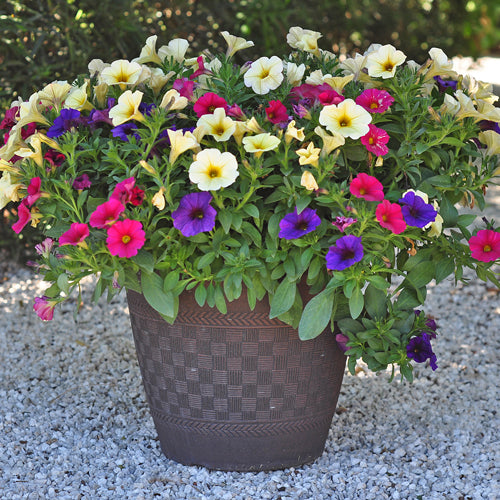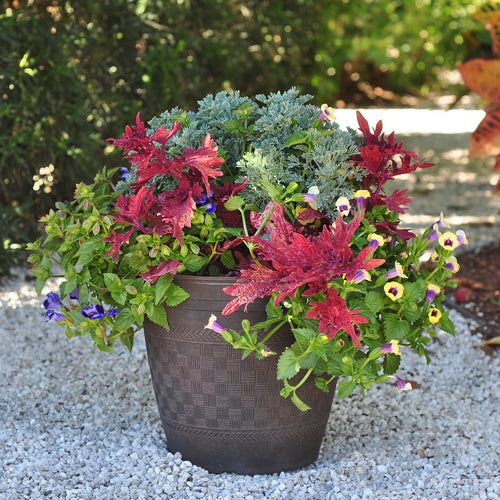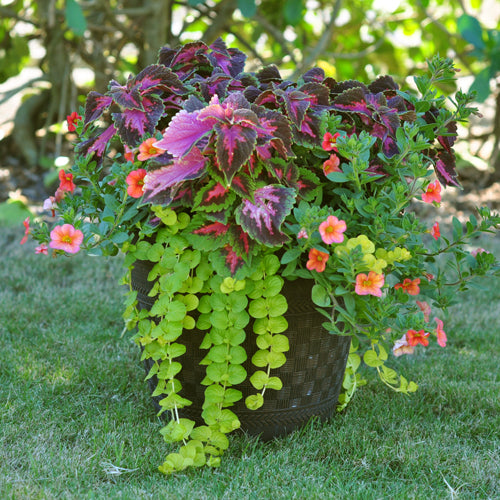By Doug Jimerson

1: Made in the Shade
Add a big burst of color to shady spots in your yard with colorful caladiums. These tropical beauties sport large, striped or splotched leaves in a rainbow of colors. Caladiums thrive in warm weather and prefer a rich, slightly wet soil. Most grow about 2 to 3 feet tall, but you can also choose dwarf varieties that grow less than 12 inches in height. They’re fun to mix and match in big pots, planters, or window boxes. Most varieties thrive in partial to full shade.
Tip: When shopping for caladiums, look at the plant tag. Some newer varieties thrive in full sun, as well as shade.

2: The Power of One
There’s no rule saying that you have to mix different kinds of flowers together to create a great container. Get a bold look simply planting different colors of a single variety in the same pot. Here, for example, a mixed bag of petchoas was all that was needed to make an eye-popping combination. The resulting mound of vibrant colors looks terrific all summer, and if the color show starts to fade, all you need to do is clip the plants back to encourage a new flush of bloom. Petchoas, like their cousins petunias, prefer at least 6 hours of direct sunlight a day and regular applications of fertilizer to keep them in top form.
Looking to buy Costa Farms plants? See our online and in-store retailer list.

3: Shady Solution
Having a shady garden doesn’t mean you need to deprive yourself of colorful flowers. In fact, you might be surprised to discover that some annuals actually prefer living on the dark side. These easy-care jewels shine out of the sunny spotlight where they receive only a few hours of filtered light a day. In this pretty pot, two different colors of torenia (also called wishbone flower) mingle beautifully with red-leaved coleus and the silver gray foliage of artemisia. As a bonus, the trumpet-shaped blooms of torenia will also attract colorful hummingbirds to your garden.

4: The Layered Look
For big impact, consider mixing plants of different shapes together in the same pot to create a tapestry of color. In this lush pot, an upright coleus holds center stage, while a trailing peach calibrachoa tumbles lightly over a carpet of golden creeping Jenny. These three plants are also versatile enough to grow in either sun or partial shade. Just be sure to trim the coleus back if it gets too large and tries to take over the pot.
Wondering how to design and plant your own containers? Watch our quick how-to video!

5: Go Tropical
Turn up the heat in your garden, by packing large tubs or containers with tropical beauties that thrive when summer temperatures soar. These gorgeous plants are a snap to grow and will have big impact flanking a door, patio, or swimming pool. Plus, if you live in the North, just bring them inside for the winter. Here, a big, glazed ceramic pot holds a spectacular mix of red mandevilla and pink tropical hibiscus surrounding a stately majesty palm. They all prefer full sun and regular applications of fertilizer to keep them looking great.

6: Celebrate Summer
Let the fireworks begin! It’s easy when you plant an explosion of color by pairing a smoldering mass of Easy Wave Velour petunias with the fiery scarlet leaves of cordyline. These sun-worshippers thrive during hot, summer weather. Just water them whenever the soil feels dry to the touch and fertilize every few weeks. Colorful hummingbirds add to the show by feasting on the bright petunia flowers.

7: Mood-Lifting Medley
Here’s an irresistible mix of spirit-lifting flowers in a medley of cheerful Easter-egg colors. It includes sunny yellow gerbera daisy, rich lavender verbena, luscious raspberry calibrachoa, and shimmering golden creeping Jenny. These plants do well in full sun or partial shade and prefer a slightly moist soil. As the summer progresses, the gerbera flowers sometimes slow down, but the calibrachoa will quickly fill the pot with color.

9: Choreograph Color
When planning your container garden, avoid planting a mishmash of colors. For best effect, it’s best to stick with two or three complementary tones. Here, for example, the sapphire blue blooms of petunia blend beautifully with the silvery gray foliage of dusty miller. Striped, dark green snake plant (Sansevieria) provides vertical interest without competing with the blue and silver theme.

10: Butterfly Breakfast
Keep butterflies and other pollinators in mind when you choose plants for your container gardens. Lantana, for example, produces a constant supply of nectar-rich blooms that bees and butterflies flock to. In this pretty pot, its bold yellow flowers mix beautifully with blue scaevola. Both thrive in full sun. Other annuals that butterflies feast on include globe amaranth, salvia, zinnia, pentas, dianthus, sweet alyssum, verbena, ageratum, cosmos, and Mexican sunflower.

11: Reach New Heights
Raise the color show in your garden to new heights by including an annual vine in your pots and planters. Annual vines such as black-eyed Susan vine, morning glory, cypress vine, cardinal climber, and hyacinth bean vine are a snap to grow and will quickly scramble up a low trellis or support. In this handsome urn white sweet alyssum and yellow pansies provide a colorful carpet under a tower of black-eyed Susan vine. Give the vines an occasional haircut to keep them from creeping over nearby plantings.

















